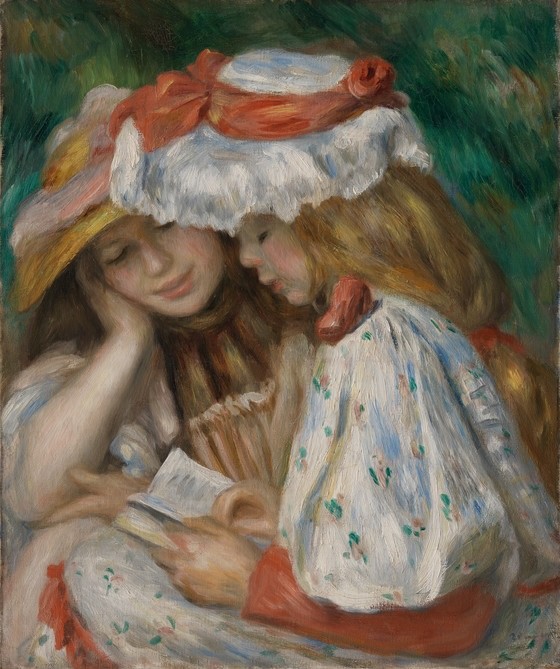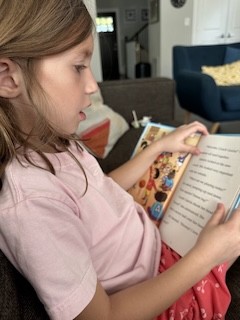Blast from the Past: This piece was first published on May 7, 2022, and was republished on October 25, 2025. The original posting explained the distinction between a comprehension effect and a learning effect. Recently, I published a book on “leveled reading” that addresses this difference more thoroughly (Shanahan, 2025). The failure to make a discernment between these two outcomes has led to many pedagogical failures. Given that, I thought this to be a good time to sharpen the points made here, providing greater clarity and some background information about the source of this unfortunate misunderstanding, along with some specific instructional recommendations. Learnability is more important than immediate comprehensibility when it comes to selecting texts for instruction, and rereading contributes to the value of such text.
Teacher question:
You say that we should teach students to read with grade level texts. But my professor (I’m working on a master’s degree in reading) says that would be a big mistake since harder texts have been found to lower students’ fluency and comprehension (Amendum, Conradi, & Hiebert, 2017). Your research says one thing and his says something else. How can I sort this out? I kind of think that he is right since my students don’t read as well when I put them in the grade level books.
Shanahan responds:
This is an easy question to answer: I’m right and your professor is wrong. Nah, nah, nah, nah, nah, nah!
Did that convince you? Well, let’s try again.
The correct answer is that it depends. It depends on your purpose.
Your professor (and the research study he cited) are focused on how well students can read a text. They are correct – students usually don’t read harder texts as well as they can read simpler ones – though there are a few exceptions to this. That means that if your goal is to ensure students read a particular text well – fluently and with high comprehension – then it’s a good idea to place them in those easier texts.
However, ensuring a strong reading performance with a particular text on a given day is rarely a reading teacher’s goal. The point of lessons isn’t to demonstrate how well students can already read some text.
No, lessons are supposed to help kids improve their reading ability. My purpose is to enable kids to read successfully texts that they cannot already read well. That’s a very different purpose, and it requires a very different answer.
Your professor is confusing reading comprehension and learning to read. He or she isn’t unique in this confusion. The original conception of the “instructional level” was based on the same idea (Betts, 1946). The originator of the original criteria for determining the instructional level, Emmett Betts, assumed that students would learn reading best with texts that would ensure high comprehension from the start. This was not a research finding, just a bit of ideology or untested theory.
The way he went about that was by identifying texts that allowed for high comprehension (75-89%) and a level of oral reading fluency that would not be likely to interfere with comprehension (95-98%).
We have plenty of studies, including the one that you cited, showing that students usually can read simpler texts better than challenging texts.
What we don’t have – despite many attempts – is convincing evidence that teaching kids from such texts offers learning advantages. Teaching with those texts has not been found to make kids better readers.
In an exhaustive review of existing evidence (Shanahan, 2025), it was concluded that research shows just the opposite. Placing most kids in such books provides no learning advantage, and often it has been found to be detrimental to learning.
There are many reasons why developing readers may find a book to be difficult: decoding and fluency challenges, unknown vocabulary, complicated syntax, subtle or confusing cohesive links, complicated or deep discourse structure, sophisticated content or ideas, lack of or failure to use relevant prior knowledge, extensiveness of the reading, and so on.
If the point is immediate comprehension, then those difficulties are a real problem. Any and all of those can interfere with understanding a text.
However, if our goal is to increase the students’ abilities to read, then those difficulties are an opportunity for teaching and learning.
When you place kids in texts that they can read as well as the instructional level dictates, there just isn’t that much to figure out. Those texts are opportunity deserts. Kids might accomplish the intended level of comprehension, but those texts afford kids little chance to increase or improve their reading ability – since their current skills are sufficient to making sense of the instructional text.
The article that you cited acknowledges this difference. “If we give students more complex texts without any support, we are unlikely to see the benefits... Specifically, we draw attention to the importance of scaffolds and instructional supports to assist students as they read more challenging texts” (Amendum, Conradi, & Hiebert, 2017, p. 146).
This quote doesn’t go as far as I would, however. It makes it sound like our purpose is to ensure comprehension – we’re going “to assist [italics added] students as they read more challenging texts.” I assume that means the teacher is going to help students to comprehend the text. I want that, too, but it should be a side effect of the main event.
What I’m referring to as the “main event” here is teaching the kids to read better – we want the kids to eventually understand this text, but our primary purpose is to provide the knowledge and tools that will allow this improvement to generalize to other texts.
I can assist kids’ comprehension any number of ways – by telling them what the text says or by reading it to them, things that many teachers do every day.
But what I really want to do is to develop in students a determination to comprehend, to recognize when that isn’t happening, to have an awareness of possible sources of that failure, and the tools that would allow them to pierce the veil of the puzzling text.
You can’t teach those things with texts the students can already grasp with minimal effort.
That’s why we should not avoid complex texts. We must teach students to read them.
How to do that? There are many scaffolds and instructional routines that have a basis in research (there are several blogs, articles, and PowerPoints about that on this site – and, of course, there is my new book) but let’s take a quick look at one easy to use support that really helps.
There is a surprising amount of research that explores the impact of rereading and usually with positive results. When understanding doesn’t come automatically from a single read, it makes great sense to reread a text in its entirety or to reread specific parts of a text.
What might you expect with a second reading?
- Improved reading fluency with lower reading times, fewer regressions, and a greater depth of comprehension (Xue, Jacobs, & Lüdtke, 2020)
- Comprehension improvement especially for low comprehenders and students with low working memory (Griffin, Wiley, & Thiede, 2008)
- Incorporation of more information into students’ text memory – particularly causally connected information (Millis & King, 2001)
- Improved literary appreciation (Kuijpers & Hakemulder, 2018)
- Improved meta-comprehension (Rawson, Dunlosky, & Theide, 2000)
- Improved integration between text and graphics (Mason, Tornatora, & Pluchino, 2015)
- Improvements in the readers’ perception of the ease of the text (Margolin & Snyder, 2018)
Having students read texts or parts of texts a second time improves reading performance. Teachers should provide guidance to students even with the rereading of texts if they are sufficiently challenging to merit such attention.
The study that reported greater awareness of causal connections on a second read (Millis & King, 2001) reported this improvement for both good and poor readers. But those gains were greatest with the better readers. Good readers had a clearer idea of what to look for when they went back and read again. Teaching students to look for causal connections in this context, including signal words (e.g., because, so, so that, if… then, consequently), makes sense. It would give the poorer readers both a better chance to comprehend the text at hand, as well as providing them some tools that would be useful with other texts.
Lack of such instruction or support may be why some studies found no benefits from rereading (Callender, et al., 2009) or that rereading can be less effective than other more intentional study approaches (Weinstein, McDermott, & Roediger, 2010).
One interesting investigation with elementary students found that reading and rereading had no impact on reading comprehension. But reading-retelling-rereading was effective (Koskinen, Gambrell & Kapinus, 1989). Perhaps the retelling step sensitized the students to what they were missing, which made the rereading more purposeful. Another study successfully guided fourth graders to reread specific parts of a text with positive results (Bossert & Schwantes, 1995).
In any event, rereading has the power to transform a difficult read into an easier one and learning to make sense of texts that one can’t already read easily is at the heart of successful reading instruction.
Tell your professor that!
References
Amendum, S.J., Conradi, K., & Hiebert, E. (2017). Does text complexity matter in the elementary grades? A research synthesis of text difficulty and elementary students’ reading fluency and comprehension. Educational Psychology Review, 30, 121-151.
Bossert, T. S., & Schwantes, F. M. (1995). Children's comprehension monitoring: Training children to use rereading to aid comprehension. Reading Research and Instruction, 35(2), 109-121. http://dx.doi.org/10.1080/19388079509558201
Callender, A. A., & McDaniel, M. A. (2009). The limited benefits of rereading educational texts. Contemporary Educational Psychology, 34(1), 30-41. http://dx.doi.org/10.1016/j.cedpsych.2008.07.001
Griffin, T. D., Wiley, J., & Thiede, K. W. (2008). Individual differences, rereading, and self-explanation: Concurrent processing and cue validity as constraints on metacomprehension accuracy. Memory & Cognition, 36(1), 93-103. http://dx.doi.org/10.3758/MC.36.1.93
Koskinen, P. S., Gambrell, L. B., & Kapinus, B. A. (1989). The effects of rereading and retelling upon young children's reading comprehension. National Reading Conference Yearbook, 38, 233-239.
Kuijpers, M. M., & Hakemulder, F. (2018). Understanding and appreciating literary texts through rereading. Discourse Processes, 55(7), 619-641. http://dx.doi.org/10.1080/0163853X.2017.1390352
Margolin, S. J., & Snyder, N. (2018). It may not be that difficult the second time around: The effects of rereading on the comprehension and metacomprehension of negated text. Journal of Research in Reading, 41(2), 392-402. http://dx.doi.org/10.1111/1467-9817.12114
Mason, L., Tornatora, M. C., & Pluchino, P. (2015). Integrative processing of verbal and graphical information during re-reading predicts learning from illustrated text: An eye-movement study. Reading and Writing: An Interdisciplinary Journal, 28(6), 851-872. http://dx.doi.org/10.1007/s11145-015-9552-5
Millis, K. K., & King, A. (2001). Rereading strategically: The influences of comprehension ability and a prior reading on the memory for expository text. Reading Psychology, 22(1), 41-65. http://dx.doi.org/10.1080/02702710151130217
Rawson, K. A., Dunlosky, J., & Theide, K. W. (2000). The rereading effect: Metacomprehension accuracy improves across reading trials. Memory & Cognition, 28(6), 1004–1010. https://doi.org/10.3758/BF03209348
Shanahan, T. (2020). Limiting children to books they can already read. American Educator, 44(2), 13-17, 39.
Shanahan, T. (2025). Leveled reading, leveled lives. Cambridge, MA: Harvard Education Press.
Weinstein, Y., McDermott, K. B., & Roediger, H. L. (2010). A comparison of study strategies for passages: Rereading, answering questions, and generating questions. Journal of Experimental Psychology: Applied, 16(3), 308-316. http://dx.doi.org/10.1037/a002099
Xue, S., Jacobs, A. M., & Lüdtke, J. (2020). What is the difference? rereading Shakespeare’s sonnets—An eye tracking study. Frontiers in Psychology, 11, 14. http://dx.doi.org/10.3389/fpsyg.2020.00421







Comments
See what others have to say about this topic.